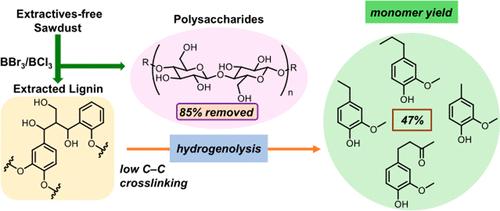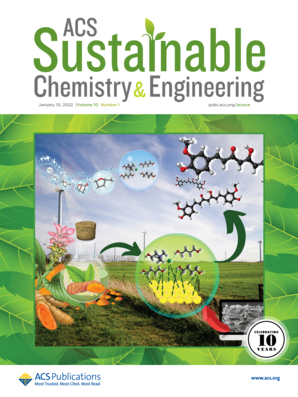硼路易斯酸萃取木材可产生优质木质素
IF 7.1
1区 化学
Q1 CHEMISTRY, MULTIDISCIPLINARY
引用次数: 0
摘要
如何将木质纤维素分离成木质素、纤维素和半纤维素,同时又不显著改变这些生物聚合物成分的化学结构,仍然是现代化学面临的一项挑战。尤其是木质素,它具有作为一种高价值原料材料的潜力,但由于难以生成低改性和缩合度的木质素,因此仍未得到充分利用。本研究对之前报道的硼路易斯酸介导的木质纤维素分离产生的富含木质素的固体("硼木质素")进行了研究,并得出以下结论:(1)硼路易斯酸萃取可从原始木质纤维素样品中去除 80%-85% 的碳水化合物;(2)所产生的木质素具有较低的缩合度,且与原生木质素结构高度相似。本文讨论了残留碳水化合物评估、解聚效率分析、异核单量子相干(HSQC)和固态核磁共振(NMR)分析,包括与已知具有低缩合度和高缩合度的替代木质素来源的基准结果。此外,还采用了两种不同的木材来源(软木白松木和硬木榉木)来生成木质素样品。白松硼木质素的解聚产生了 47% (±9.5)的可萃取单体,这与最先进的低缩合木质素生成方法(56 ± 7.8%)相比毫不逊色。从榉木中生成硼木质素后,氢解观察到油样出现了意想不到的不稳定性。当样品进行老化(减少 11%)或浓缩(减少 30%)时,观察到颜色发生剧烈变化,同时出现沉淀和单体产量降低。根据核磁共振光谱分析,推测这种不稳定性是由于木质素支架上的甲氧基位点在硼的介导下发生了脱甲基作用。本文章由计算机程序翻译,如有差异,请以英文原文为准。

Boron Lewis Acid Extraction of Wood Generates High Quality Lignin
The separation of lignocellulose into lignin, cellulose, and hemicellulose without significantly altering the chemical structures of these component biopolymers remains a modern chemical challenge. Lignin, in particular, has potential as a highly valuable feedstock material but remains underutilized due to the difficulty of generating lignin with low modification and condensation. This work investigates the lignin-rich solids (“boron lignin”) generated from a previously reported boron Lewis acid-mediated lignocellulose separation and concludes that (1) boron Lewis acid extraction removes 80–85% of carbohydrates from the original lignocellulose sample, and (2) the resulting lignin possesses a low condensation level and high similarity to native lignin structure. Residual carbohydrate assessment, depolymerization efficiency analyses, heteronuclear single quantum coherence (HSQC) and solid-state nuclear magnetic resonance (NMR) analyses are discussed, including benchmarking results with alternate lignin sources known to possess low and high condensation levels. Further, two different wood sources (white pine, a softwood, and beechwood, a hardwood) were employed to generate lignin samples. Depolymerization of a white pine-derived boron-lignin produced 47% (±9.5) of extractable monomers, which compares well to a state-of-the-art method to generate low condensed lignin (56 ± 7.8%). An unexpected instability of the oil sample was observed following hydrogenolysis of boron lignin generated from beechwood. Dramatic color changes coupled with precipitation and lowered monomer yields were observed when samples were aged (11% decrease) or concentrated (30% decrease). Based on NMR spectroscopic analyses, this instability is postulated to arise due to boron-mediated demethylation of methoxy sites on the lignin scaffold.
求助全文
通过发布文献求助,成功后即可免费获取论文全文。
去求助
来源期刊

ACS Sustainable Chemistry & Engineering
CHEMISTRY, MULTIDISCIPLINARY-ENGINEERING, CHEMICAL
CiteScore
13.80
自引率
4.80%
发文量
1470
审稿时长
1.7 months
期刊介绍:
ACS Sustainable Chemistry & Engineering is a prestigious weekly peer-reviewed scientific journal published by the American Chemical Society. Dedicated to advancing the principles of green chemistry and green engineering, it covers a wide array of research topics including green chemistry, green engineering, biomass, alternative energy, and life cycle assessment.
The journal welcomes submissions in various formats, including Letters, Articles, Features, and Perspectives (Reviews), that address the challenges of sustainability in the chemical enterprise and contribute to the advancement of sustainable practices. Join us in shaping the future of sustainable chemistry and engineering.
 求助内容:
求助内容: 应助结果提醒方式:
应助结果提醒方式:


